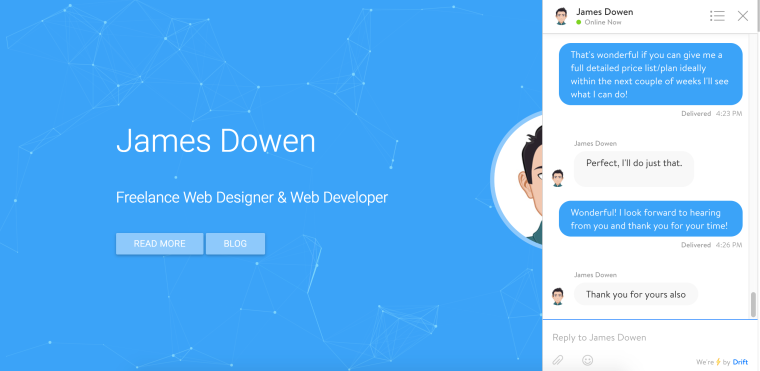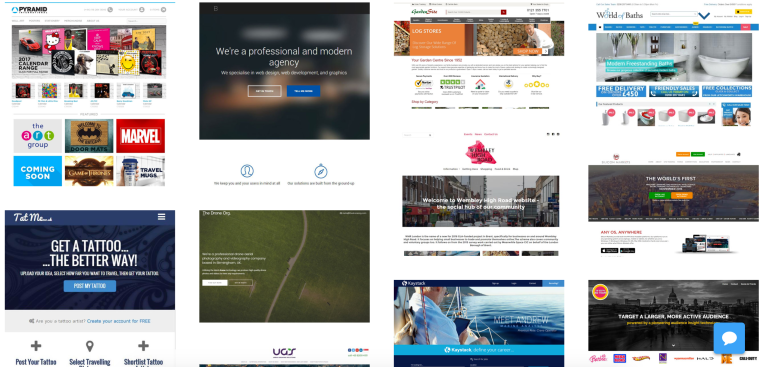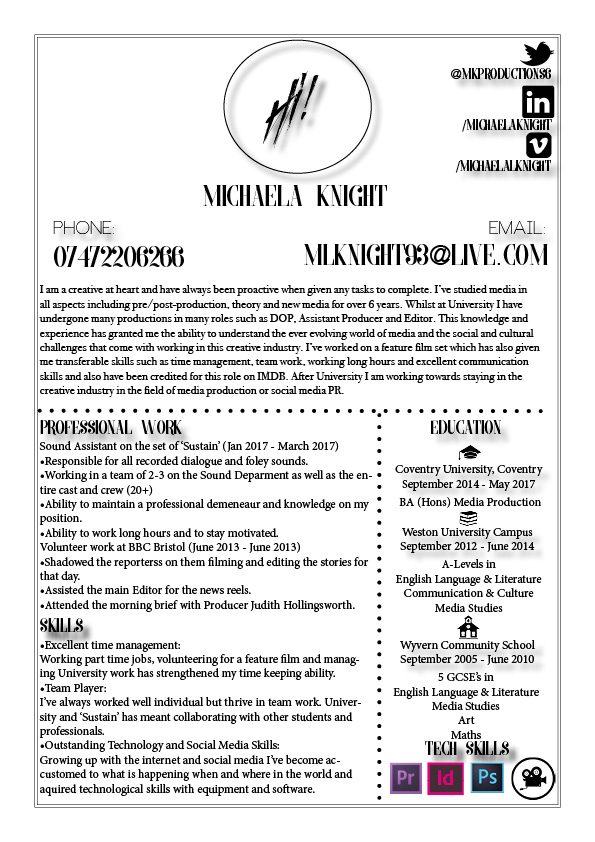
Tag: final year
#364MC // Professional Experience // Research & Development // Camera Op
Ever since studying Media I have always loved the visuals, which might be something everyone would say as it’s the thing we see first. What camera angles are being used to display an emotion, event etc. For almost every university project I have been camera assistant or Director of Photography. My inspiration stemmed from Stanley Kubrick and David Lynch – two people who have influenced my work and what I want to portray through film ever since I started studying film.
I will always remember Kubrick’s ‘One Point Perspective’ which I’ve tried to embody in some of my own work. Below is an example of his technique:
<p><a href=”https://vimeo.com/48425421″>Kubrick // One-Point Perspective</a> from <a href=”https://vimeo.com/kogonada”>kogonada</a> on <a href=”https://vimeo.com”>Vimeo</a>.</p>
Whilst researching into the role of a camera assistant I came across a book titled ‘The Camera Assistant’s Manual’ by David E. Elkins (1991) within the first pages I discovered some of the history behind the technology used before camera’s became more complex and required individuals to learn this skill “The process of motion picture photography started when George Eastman introduced the first 35 mm film in 1889, and Thomas Edison, along with his assistant W. K. L. Dickson, designed the Kinetograph and Kinetoscope, also around 1889. Various reports indicate that the patent was applied for in 1891 but that it wasn’t granted until 1897. The Kinetograph was used to photograph motion pictures, and the Kinetoscope was used to view them. These early pieces of equipment were very basic in their design and use. As film cameras became more complex, a need developed for specially trained individuals to work with this new technology and equipment. Two of these individuals became known as the First Assistant Cameraman (1st AC) and the Second Assistant Cameraman (2nd AC).” Billy Blitzer, one of the first well known cinematographers who worked alongside Director D. W. Griffith was assigned what they would call back then, a Camera Boy, which is today’s Camera Assistant role – to simply carry the equipment and make a note of the shots for the day as there was no Script Supervisor back in 1914.
“When you start looking for that first professional job, any experience, even if it is on a student production, increases your chance of getting a job. ” It is true that getting experience on a film set whether that being a student production or a professional production it will increase the chances of landing the job in media which you desire. I found that my opportunity on a real film-set came from working with individuals who had made connections doing the same routine – working on student projects, contacting professionals and then landing experience even if it is volunteer work. There’s something very humbling and more rewarding when working on a set you have volunteered for – I found myself working extra hard to prove my worth of being there whilst on the set of ‘Sustain’.
With this in mind I decided to do a little research on how to go about applying for a role as Camera Assistant:
- have good colour vision, and good hand-to-eye co-ordination
- have a working knowledge of how the relevant camera equipment works
- have good communication skills and show diplomacy and sensitivity when working with artists, production staff and crew
- be able to take direction and work as part of a team
- be able to carry out instructions with great accuracy and attention to detail
- be able to work under pressure and in stressful situations
- be able to frame and compose shots after you’ve gained some experience
- have good IT skills
- possess physical stamina for working long hours and moving heavy equipment
- understand the requirements of the relevant health and safety legislation and procedures
Intensive industry experience is the best route into this role, having gained a grounding in the basic camera skills and knowledge required. You could begin your career as a Camera Assistant, and then work your way up through the ranks of the camera department over several years.
When searching for job vacancies a lot of free-lance work was cropping up over the place as well as trainee jobs – which is inspiring to see as most people would assume media jobs are sparse. Just by searching ‘camera assistant’ into a job search website like Indeed.co.uk pages and pages of jobs were displayed under that same criteria.
References
“Camera Assistant (Studio And Outside Broadcast)”. Creativeskillset.org. N.p., 2017. Web. 5 Apr. 2017.
Elkins, David E. The Camera Assistant’s Manual. New York: Focal Press, 2013. Print.
#364MC // Professional Experience // Research & Development // Editor
For as long as I can remember, ever since I watch MTV Behind the Scenes of how music videos and films are created – I fell in love with the post production editing. I was intrigued with how someone could take raw film and turn it into something that creates a certain emotion and how special effects can alter the appearance of almost anything.
I’ve researched into editing jobs before so going back and refreshing my memory and seeing how it might of changed was exciting. I went straight to the creativeskills website as this is a reliable source for information on any media production career and the requirements needed. For an editor they are as follows:
- Working closely with the Director to craft the finished film
- Working in an edit suite for long hours
- Running a team of assistants and trainees on big productions
- Have technical aptitude
- Have wide experience of the post production process
- Be familiar with a variety of computer editing equipment
- Understand dramatic storytelling to create rhythm, pace and tension
- Be creative under pressure
- Have imagination and an understanding of narrative
- Have excellent communication and interpersonal skills
- Have highly developed aesthetic visual awareness
- Be able to lead a team
- Have patience and attention to detail
- Have good organisational skills
- Understand the requirements of relevant health and safety laws and procedures
Traditionally, you could go from being a Runner to a Trainee, Second Assistant, First Assistant and eventually to become an Editor. However, with digital editing, 2nd Assistants are now only employed on very big budget films.
As a Trainee with at least two years’ experience you would have to work as an Assistant in television or on low budget films for a considerable period of time before becoming First Assistant on feature films. Some big budget productions take on Trainees and Second Assistants, and it is important to keep up to date with films in pre-production by reading the trade press.
If you can work with an Editor as an Assistant, you may be allowed to carry out the assembly edit of some sections of the film. If you can become an experienced Assistant, you may also work as an Editor on short films, which will enable you to showcase your talents.
It’s really rather easy to become an editor from the comforts of your own home – technology has granted consumers access to a variety of editing softwares to use for their own devices without having to be hired by a large company. These prosumers are able to create anything from being multiple roles all at once, editing software now comes with every computer and smart phone device whether that be Windows Movie Maker or Final Cut Pro everyone in today’s society is an editor to some extent.
I remember when I used to create home movies and edit them on Windows Movie Maker to then show my mum pretending it was a movie premier. This passion has followed me through the last 6 years of studying media. Editing is a very delicate and time consuming process that I think a lot of people overlook. I have spent countless hours editing together a piece of work that may ultimately end up only being 3 minutes long. But that makes the process all the more beneficial and rewarding to think at the end of it all, you put that together.
An editing job is something I feel anyone can get into with practise and experience, like most things, it also doesn’t require any qualifications as the best way to learn is through shadowing others – much like I did when I shadowed the head editor at BBC Bristol a few summers a go. Editors sometimes get overlooked when being credited as everyone might see their work it’s the Director and actors who get more recognition for the piece. However, being the editor is a vital part to any film or tv show and with the exposure we have as consumers today to access editing software it’s inspiring to see more and more people learning to create amazing media content.
References
Balmuth, Bernard. Introduction To Film Editing. 1st ed. Boston [u.a.]: Focal Press, 1989. Print.
“Editor | Creative Skillset”. Creativeskillset.org. N.p., 2017. Web.
#364MC // Professional Practice Portfolio // Work Experience // ‘Sustain’ Final
The time has finally come where we wrap up on the set of ‘Sustain’. It has been one hell of a journey and I have learnt and experienced so much more than I ever thought I would. Three months of working 24 hour weekends in all weather conditions and till late hours and I wouldn’t of had it any other way.
‘Sustain’ was my first ever time on a real film set and also as Sound Assistant, before this I had only dabbled with Sound and kept myself to camera op but I’m so glad I challenged myself with Sound as it has quickly become something I am very passionate about and would love to pursue further in my journey as a media creative.
To say that this was easy would be false, to say it was extremely fun and rewarding would be more accurate. It was one of the most difficult things I had ever put myself through but it never felt like ‘work’ – around talented, fun, encouraging and enthusiastic individuals made every day feel like we was just kids making home movies with a lot better equipment.
From this experience I have come to understand that to make a master piece you need a lot of hands and creative vision – each persons opinion and talent was put to good use and learning how each person had a certain role which would overlap into other roles was exciting to see. Often on days we would have people helping Sound who usually work as First AD or even Editor. Everyone was knowledgeable in each area which I feel confident to say I am now too. I have mingled and experienced first had what it’s like to be a DoP, Editor, Director and so on and couldn’t be more thankful for this opportunity.
I have included some photos from our shoots and I can’t wait to work with these incredible artists in the future.
364MC // Professional Practice Portfolio // Research & Development #1 – Sound Assistant
During the months of January to March I was fortunate enough to get some work experience on a real film set for Birmingham Filmmakers as Sound Assistant. My main role was to operate the Boom Pole and Zoom Mic.
It was a very insightful experience, I’ve never really been sound op before as I tended to stick to camera work throughout university projects but the more I was in control of sound the more I fell in love with that role. It has opened my mind to the possibility of not just limiting myself to camera work or becoming a DoP.
A Sound Engineer makes a salary of £16,000 to £35,000 per year and works variable hours per week. There are no initial requirements to becoming a sound engineer, but some knowledge and passion for sound is essential.
The types of courses that help with experience would be music technology, sound engineering and media production. I have learnt a lot about sound throughout my three years at Coventry University and even more from being on the set of ‘Sustain’ as Sound Assistant.
The skills required for this type of career are as follows:
- excellent hearing
- excellent practical skills
- a high level of attention to detail
- the ability to cope with long hours and tight deadlines
After working on ‘Sustain’ I feel as if these skills have enhanced for myself, I have very close attention to detail when it comes to sound and working 12 hour days has given me the ability to cope with working through being tired and deadlines.
Through more research there are many avenues a person interested in a sound career could take:
- production sound – recording sound on set or location
- post-production – putting the final soundtrack together in an editing studio
On a production sound team, your day-to-day duties may include:
- setting up equipment to suit the acoustics and the sound designer’s instructions
- selecting and placing fixed microphones
- operating the boom (a microphone on a pole, used to get close to the sound source)
- checking sound quality
- recording sound onto digital devices
- servicing and repairing equipment
- playing music or sound effects into a live programme
On a post-production team, your duties may include:
- following a sound designer or sound supervisor’s instructions
- mixing and balancing speech, effects and background music
- editing speech to fit the action on screen
- creating extra sound effects and adding them into the soundtrack
The progression with this chosen career could start from freelance work to working for a large company or a station locally or nationally. The first steps into this role would be taking a trainee position/shadowing someone already in the industry through Creative Skillset I found a ‘Trainee Finder’ program that helps allocate people looking for experience in certain roles in the media industry by helping them with course in all locations and roles. This is something that I’m signing up to and hoping to gain after university a long side any job roles I land.
I looked into Sound Engineer roles as I felt this was crucial to understanding sound itself and how to excel in this career. Mark Linett started his sound career whilst at college by starting his own PA Company. While running the company, he began working with artists such as Seals & Crofts, Sha Na Na, and Livingston Taylor. He later than worked for Warner Bro’s Studio, although he specialises in music sound engineering and has produced many well known tracks. He was also nominated for best engineered album which he recorded and mixed for Brian Wilson who won his first solo Grammy in 2005 for “Best Rock Instrumental Performance” for “Mrs. O’Leary’s Cow” from his best-selling SMiLE album.
Whilst looking for job roles in Sound there is an abundance of opportunities, most of them located in London which is perfect for me as this is where I aim to end up. A lot of the jobs are positions for candidates with transferable skills such as this role at London Live https://www.indeed.co.uk/viewjob?jk=896888109b0d70ae&q=Sound+Operator&tk=1bci88mf491dhalb&from=web the role includes sound, camera and lighting experience.
References
“Looking For Film Trainees? – Trainee Finder”. Hiive. N.p., 2017. Web. 31 Mar. 2017.
“Sound Assistant”. Creativeskillset.org. N.p., 2017. Web. 31 Mar. 2017.
“Studioexpresso – Producer Mark Linett”. Studioexpresso.com. N.p., 2017. Web. 31 Mar. 2017.
“TV Or Film Sound Technician”. Nationalcareersservice.direct.gov.uk. N.p., 2017. Web. 31 Mar. 2017.
#364 Work Experience – ‘Sustain’
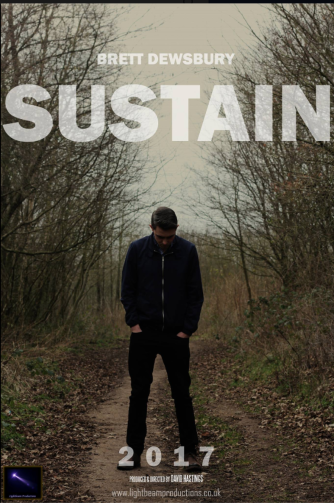
(Sustain (2017) promotional poster)
A fellow student on my course posted a couple of weeks a go about needing help for a new feature film coming out titled ‘Sustain’ the new film from Midlands Director David Hastings & Producers Troy Dennison and Keiran Bowers (Checking In, Brink, The House of Screaming Death). A Birmingham crew with amazing talent and even more amazing personalities.
On January 14th I was fortunate enough to be picked as Sound Assistant and start my first full day on a real film set. I have been to 3 shoots already lasting 12 hours each. I’ve learnt so much already from these first few days, about sound, about cinematography and editing. Director David is truly an inspirational man with a lot of experience under his belt and his crew have been so welcoming and informative with any questions I have.
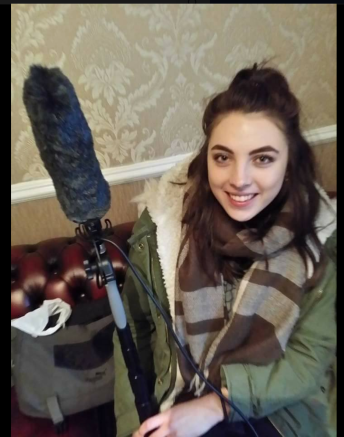
(A slightly awkward shot of me with the boom pole…)
The filming goes on until March with a week long shoot in February, being Sound Assistant is a lot more taxing than it sounds but it’s hugely rewarding. Considering I’ve never been the one to choose sound as my role in previous productions with uni it’s become one of my favourite things to do and has opened up my skills in the film environment. I’m loving learning different positions and get to experience a piece of everything on set.
One of the difficulties with filming that I found during these past few days was that trying to record sound outside is almost impossible. To make it even more challenging we had wind and rain and was on a busy street with cars and planes constantly flying/driving past. We managed to make it work and Sam, the editor, is incredible with sound editing and can work with the material we got.
On Sunday 22nd January, Karen the first for sound, had to leave to film something else at 6pm so as sound assistant I had to fill in the role and take charge. At first I was intimidated and nervous to speak up but after the first couple of takes I found my voice and was able to really take charge in my area – giving the director the nod when the sound was perfect or the shake of the head when it wasn’t and discussing what works best and what doesn’t. It was really satisfying knowing that I had some sort of power during this production, if the sound quality is awful then it has to be re-done. In a sense I felt like a mini director of sound saying when to cut and when to go, cause if sound isn’t ready no one is.
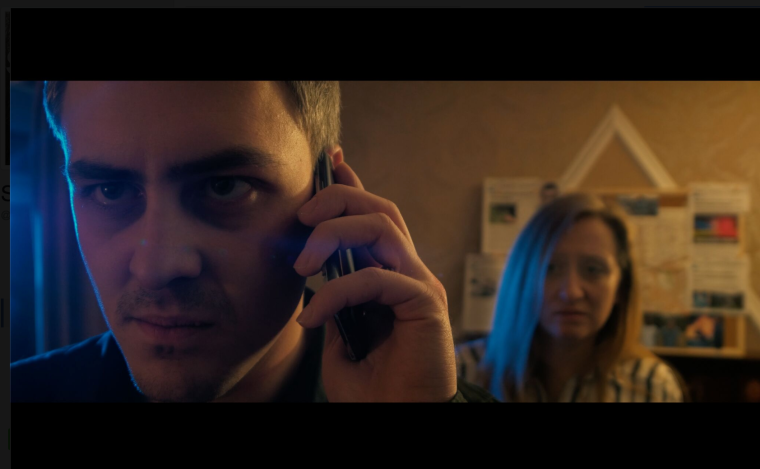
(The first official production still from Sustain featuring Brett Drewsbury as Keiran Flank and Laura Evenson as Kara Marshdale.)
I’m really excited for the next couple of months to see where it takes us and meeting more cast and crew. I’ll continue to blog about each shoot with what I’ve learnt from each session. Watch this space…
Evaluation of FMP CW2 // For Submission
The planning for my FMP has been an ongoing process for about 3 months. I started thinking about what I wanted before Christmas and it was a very vague idea of holding an exhibition, much like an art installation but with all the complications that come with being able to pull that off successfully I had to re-plan and re-evaluate what it is that is within my possibilities at this point in time. 360MC has been a challenging module, which I have been frustrated and excited about – I’d have it no other way as a challenge means it’ll be all the more worth it in the end. During 360MC and the creative artefacts I found new ways of expressing myself creatively through different techniques such as stop animation, split-scan and photography. Although my final major project doesn’t necessarily embody these first three artefacts I know it has helped me to open my mind more artistically when thinking about my fmp.
The idea for creating an interactive website documentary was recommended to me by one of my tutors. At first I thought “oh god, I can’t do this” it felt huge, more than what I was capable of, and it still is a huge project but after more weeks of thinking about it and the details to make it possible it became more of a reality that actually, this could work. I’ve always loved interactive websites, being a internet junkie and a fan of the ever evolving way media is displayed on different platforms, I believe an interactive website is something that will really push me to excel creatively and artistically.
I’ve been passionate about feminism and body positivity for a long time now, having felt my own share of body shaming and not feeling like I can be my own person or express myself truly because of what people would say about me in real life and over social media. It would be false to say that social media doesn’t have a huge impact on the world and it’s youth and it will continue to grow and be more powerful. So, I figured to help not only myself but others, to embrace it’s rapidly growing pace and create something that everyone worldwide could have access to. To feel empowered and not suffocated.
My production website is something I have taken a lot of time into making as professional as I possible could, I displayed everything I could think of to get my message across in a stylistic and modern way, an aesthetic I have always been associated with. I made it concise and informative to really show my desire for my fmp and as a media professional and I believe I did this accordingly.
I always knew, ever since starting the media production course here at Coventry University, that my fmp was going to be the most difficult project I’ve ever done – and personally what I’ve decided to do it will be the most challenging thing for me to pull off individually, but I know that I am capable of doing it and doing it well. Since I am the producer/director of the project I will search for volunteers but ultimately I am the DoP, sound and editor for this project and it will embody everything I have to offer as a media artists.
For future improve, I will spend much more time researching and understanding my platform, for example, I don’t know anything about building a website so will need to hire help in. In future I’d like to be able to have these transferable skills and the time to perfect them so that if I want to create more interactive websites I will have the skills needed to do so independently. As much as I already know about documentary, I’d also study this further and develop a better understanding of what it means to create a move documentary as well as tuning my feminist knowledge on self-acceptance movements.
Ultimately, I am happy with how I have grown as a media professional and as an individual since starting this course. I have develop a much wider understanding to the media industry in many ways, discovered new skills, styles and theorists. I’ve become more confident with equipment and expressing my ideas creatively. With my proposal video I believe this shows as it’s something quite different from the others on my course . I am eager to get started on this huge part of my life and really showcase my abilities as a student of Coventry University and as a media professional.
FMP Proposal CW2 // For Submission
Below is my final major project (FMP) proposal for ‘Femme’ An Interactive Website Documentary. Looking into the real stories, experiences and struggles of real women dealing with the constant need to meet societies beauty standards in social media today.
I’m happy with what I managed to fit together, unfortunately there is limited footage of my own as I haven’t been able to film any of the participants as of yet as they’re still to be 100% confirmed. However, I believe the message in this proposal is clear and expresses my passion and enthusiasm for the body positive movement in social media.
Michaela Knight // FMP Proposal // ‘Femme’ an Interactive Website Documentary from Michaela Knight on Vimeo.
I’ve also included the transcript for my proposal below:
Hi, my name is Michaela Knight and this short video is my proposal for my online project “Femme”. In 2016 I experienced a lot of feedback on one of my photos on my personal Instagram account. The photo itself was a topless image, with only my back on show. Some people may see this as provocative, as sensual – my purpose for this photo was I simply liked the way I looked. Once posted I received messages from students and strangers about the photo saying I had “changed” or this wasn’t “like me” – I found this odd because in fact, this was me it couldn’t be more me. After all it was my body.
This brought my attention to the year 2015 when the body positive, “Free the Nipple” and female body empowerment movements really blew up on social media. Social media is more than ever the culprit to criticising female body image, nurturing it or destroying it there is a sense of power within social media that controls how we see others and ourselves. I myself have been a feminist for many years and have followed these movements but never acted on it. A model named Charlie Howard popped up on my newsfeed one day starring in a short video by a company called StyleLikeU and their project “What’s Underneath” and I immediately fell in love with what she was pushing for – her own project “The All Woman Project” and telling her story of criticism and body shaming in the modelling industry – what captured this and made it all the more powerful was the fact she spoke starting fully dressed and ending her interview in her underwear. To me this is power, not vulnerability.
From here on out a spiral of instragram account stalking and following later it hit me – I want to create something that I am passionate about, that will get peoples attention, provoke thought and inspire women of all ages, shapes and skin tones.
My proposal is to create an interactive website that tells the stories of a variety of women, including myself, their struggles with self-acceptance and how they have overcome these. To show that being vulnerable is not being in your underwear, is not showing your body and is not letting yourself be you. The website was stylistically inspired by a another website called “blacknegative.com” a beautifully designed website that flows with ease and elegance – obviously mine would have images of the female form, I’d like to express this in an almost “grudge”, rebellion aesthetic somewhat similar to how the Sex Pistols promoted their image – anarchy in fuelled or like the style of the Guerrilla Girls a feminist activist group.
I’ve contacted many of these movements via email and have had a response from one a company called RAW Beauty Talks. I’m hoping to get as many supporters or volunteers from these movements as possible – even if I receive one, or none I will ask friends, family, strangers to volunteer to be apart of the 10, 3-5 minute clips that will showcase on my website. These will be filmed in a documentary style, having the volunteers dressed comfortably whether that is fully clothed or in their underwear, being themselves – it will be an intimate shoot with close ups to really showcase the emotions of each person.
My aim is to bring recognition to an already rising movement of female empowerment through an interactive, engaging, touching and raw website. The girls of today are the women of tomorrow and if we don’t continue to encourage and empower them, make them see their beauty that is not defined by social media – then there will be no tomorrow.
Thank you for listening.
FMP Production Folder CW2 // For Submission
Here is the link to my FMP Production folder:
http://mlknight93.wixsite.com/femmefmpproduction
The screenshots below are of my website:
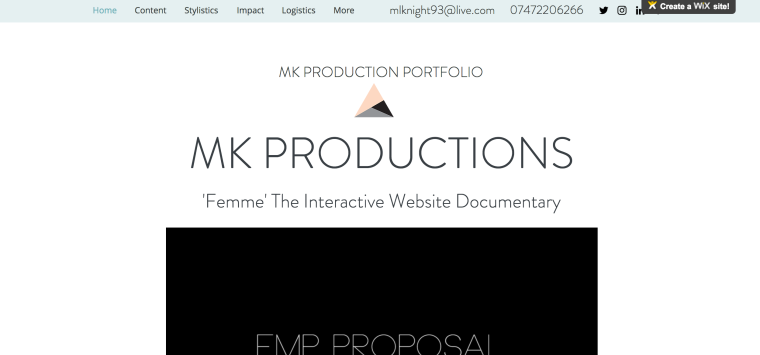
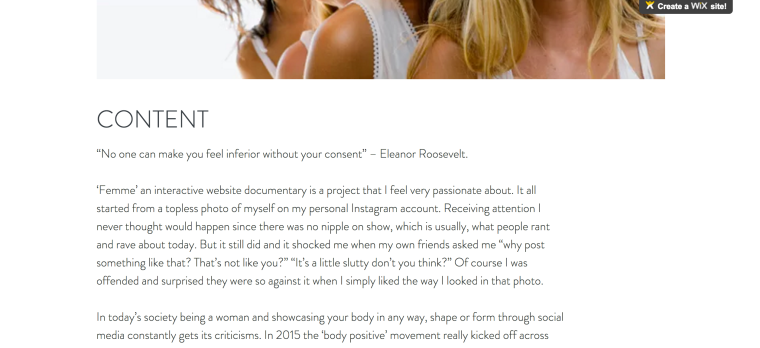

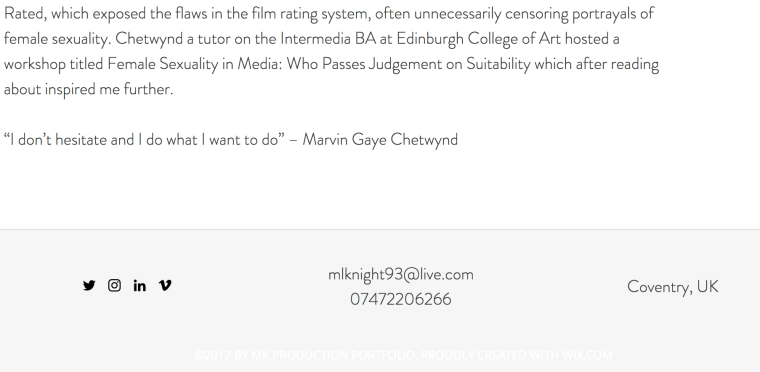
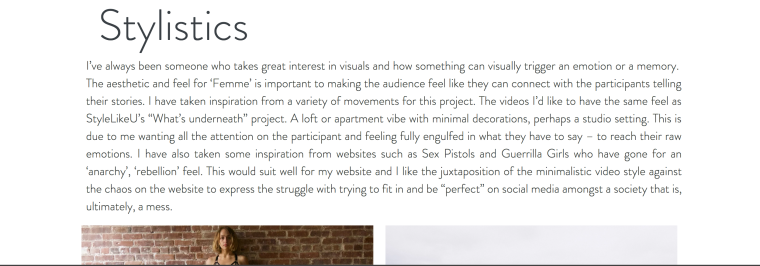
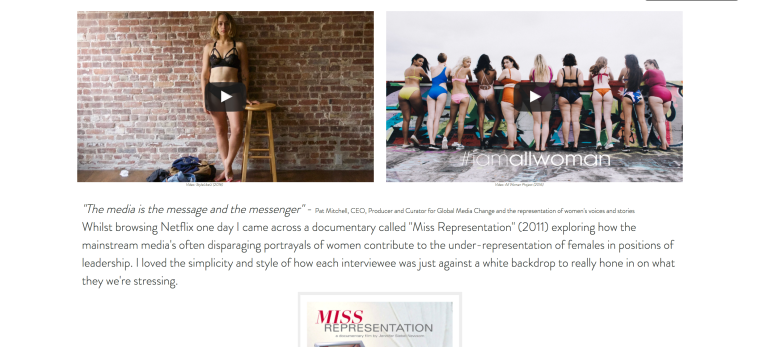
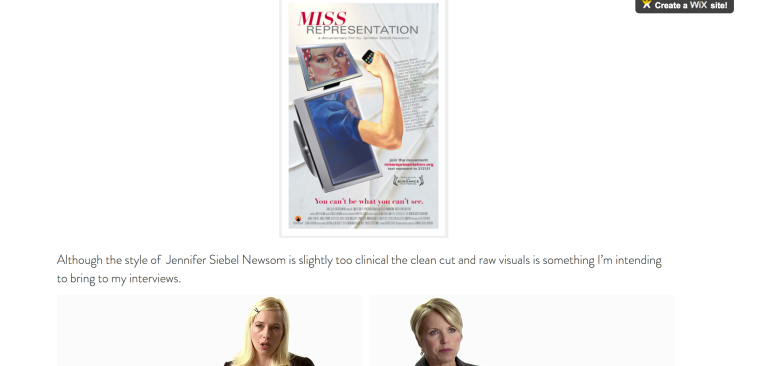
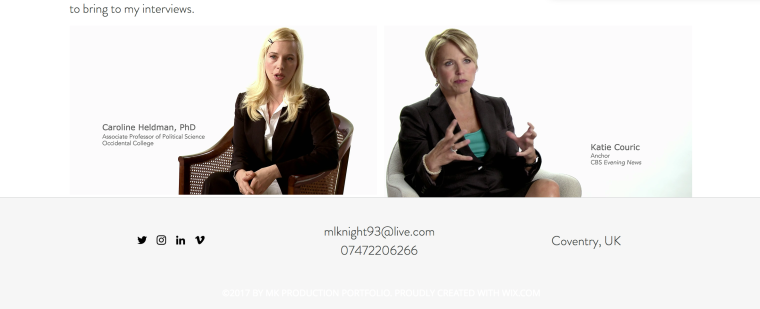
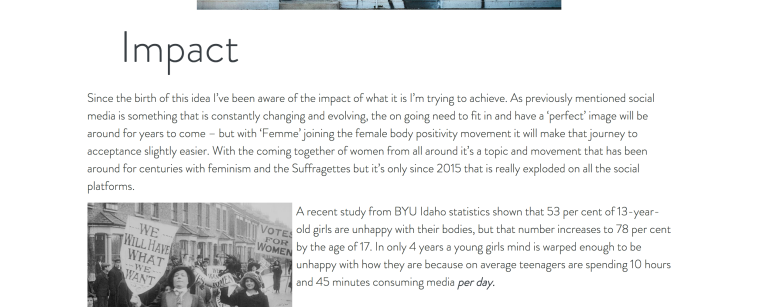
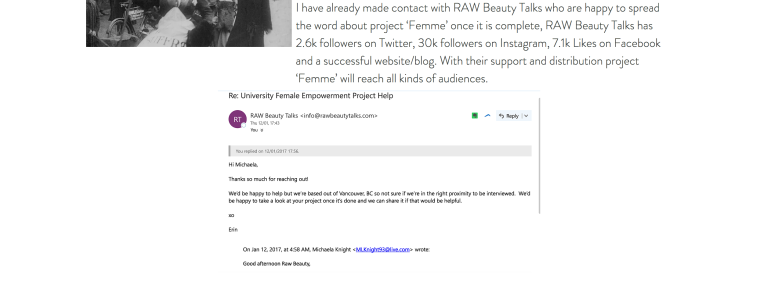
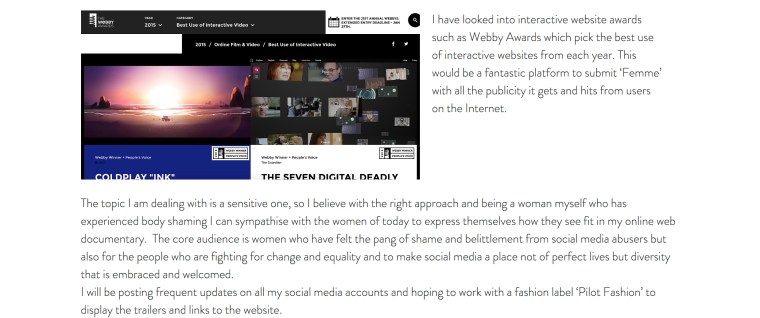
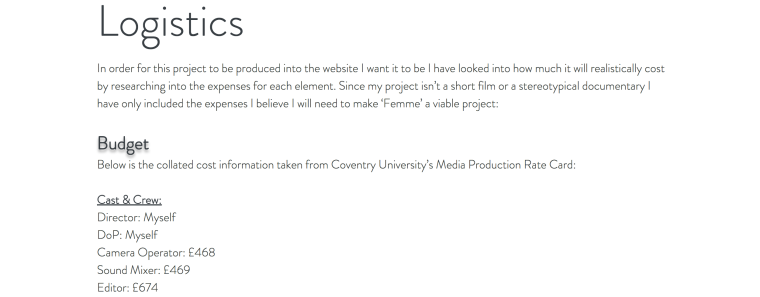
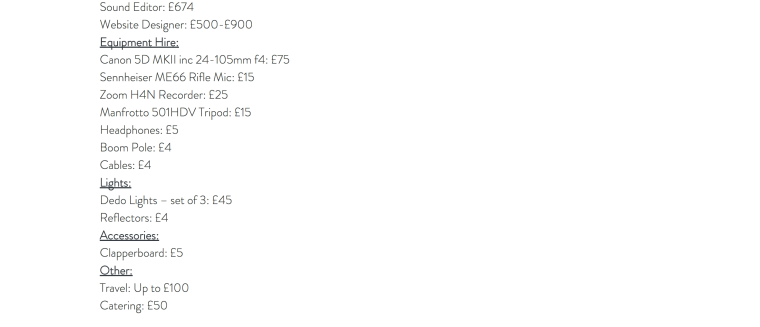
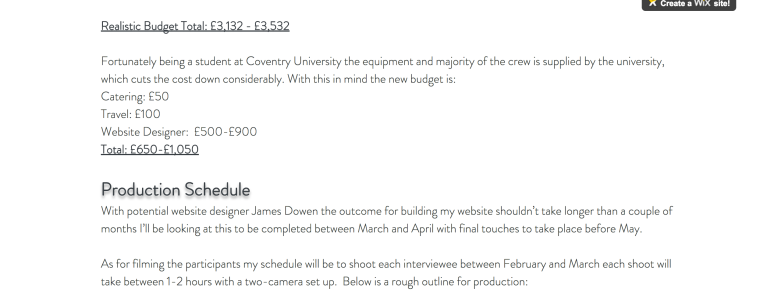
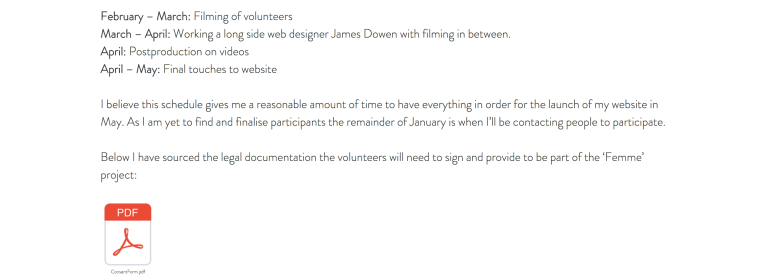


R&D // FMP CW2 // Website Designer Research // For Submission
First and foremost, I am no website designer. For project ‘Femme’ to be a success I’ll need to hire a website designer to help me. I’ve spent hours researching different designers and kept coming to the same dead end of dodgy websites, or web site designers who didn’t cover interactive designs that specified to my needs.
I gave up looking on generic website designer pages that were owned by a bigger company and started searching for freelance workers. I came across a designer named James Dowen based in Birmingham who has 6 years of work experience under his belt in web design. His website was very impressive, with interactive elements and a chat to speak to him directly.
We spoke for over an hour about what it is I was looking for and I gave him my examples, from the conversation we had it seems promising. There will be future emails and the finalising of prices and details but it seems like this is the designer for me.
Below is some examples of his previous work, his own website and a screenshot of our conversation:
